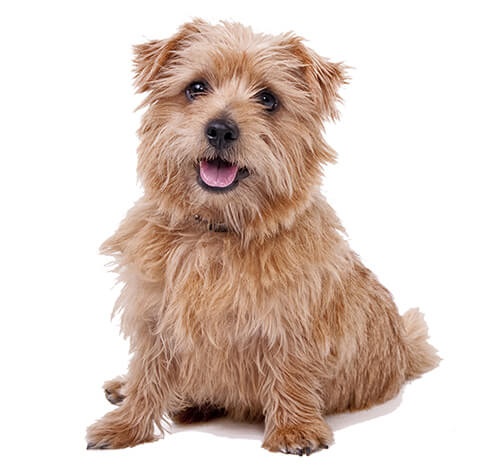
An energetic, compact and hardy breed, the Norfolk Terrier originated in England where farmers used them to bolt vermin such as foxes from their dens. Admired for his gameness, loyalty and charm, the Norfolk Terrier does well in families with other animals. He is known for his ability to adapt to any situation, making the breed ideal for city or country life. An affectionate, loving companion, the Norfolk requires regular brushing and stripping to maintain his coat.
DID YOU KNOW? The Norfolk Terrier was known as the Norwich Terrier with drop ears until 1979 when it became a separate breed.
The need-to-know
- Dog suitable for non-experienced owners
- Basic training required
- Enjoys active walks
- Enjoys walking an hour a day
- Small dog
- Minimum drool
- Requires grooming once a week
- Non hypoallergenic breed
- Chatty and vocal dog
- Guard dog. Barks and alerts
- May require training to live with other pets
- May require training to live with kids
Personality

Like most terriers, the Norfolk is clever, active and often surprisingly tenacious for their size. Unlike many however, they are social with others, friendly, cheerful and tolerant - and generally good with children.
History and Origins

Country of Origin: England
The Norfolk Terrier didn’t become a separate breed until 1964 and up until then, they were just looked on as a variation within the Norwich Terrier breed and so their histories are the same.
The Norfolk’s origins can be found liked closely to Cambridge University in the late 1800s. It was fashionable for the sportier of the undergraduates to own a particular type of terrier that was being bred in a livery stable in Trumpington Street which ran along the back of several of the colleges. These small working terriers were put to work as college ratters, and as the students lived and socialised together, their dogs had to be equally social and indeed they would work in a pack.
It was one of these dogs, a sandy coloured dog called Rags, that is credited with being the founding father of both the Norwich and Norfolk Terriers that we know today.
Until 1964, the drop eared dogs were still classified as Norwich Terriers but after this date, the two were kept separate with the drop-eared dogs being called Norfolks.
Nutrition and Feeding

Small dogs have a fast metabolism, meaning they burn energy at a high rate, although their small stomachs mean that they must eat little and often. Small-breed foods are specifically designed with appropriate levels of key nutrients and smaller kibble sizes to suit smaller mouths. This also encourages chewing and improves digestion.
Exercise

This little terrier needs an hour’s exercise a day but will be active and into everything the rest of the time, and they love games and play. They love the outdoors and particularly like digging and so a dog-digging pit in the garden would be most appreciated and will prevent them tunnelling in the flower beds!
Other Information

Health and Common Issues
Like many small breeds, they can suffer from kneecaps that may temporarily slip out of place (luxating patellas), but generally the Norfolk Terrier is a hardy breed. The breed club monitor the health of the breed carefully and should be contacted for the most up-to-date information and details of any DNA or additional testing they recommend. Breed Clubs can be found on the Kennel Club website.
Space Requirements
The Norfolk can live in a small house or flat as long as they have access to the outdoors for exercise and toileting
Training Norfolk Terriers
The Norfolk has a rather non-terrier attitude to training in that they enjoy working with their owners and can be trained to be surprisingly obedient. They should be taught a good recall however as the sight of a squirrel may well turn them suddenly deaf!
Best Family Dog Breeds
The Norfolk is one of the best terriers for children as they are gentle and patient with them. While many dogs are traditionally thought of as being good with children, all dogs and children need to be taught to get on with and respect each other, and be safe together. Even so, dogs and young children should never be left alone together and adults should supervise all interactions between them.
Did You Know?
- People get confused which is the Norfolk and which is the Norwich. Just remember that there is an ‘f’ in Norfolk and they have the ‘folded’ ears which the Norwich has pointed ears like a ‘witch’s hat’.
- They’re hardworking and have been named ‘perfect demons’ in the field.
- The breed was invented by Frank “roughrider” Jones and were originally known as “Jones Terriers”.
- They’re not just great working dogs, they’ve also been very successful in the showring.
- Norfolk Terrier’s are incredibly affectionate and don’t like living outside and they’ll always happily curl up on your lap.